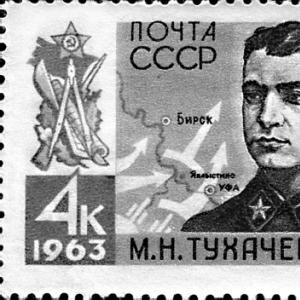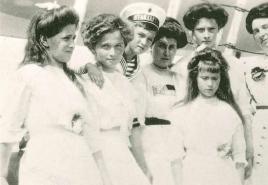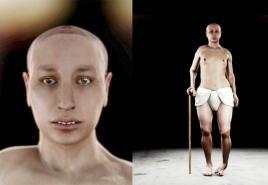Poodles - what they are and how to choose. Description of the appearance and character of dogs of the poodle breed Standard Poodle
In terms of intelligence, poodles are leaders among other dog breeds. They are inquisitive, friendly, moderately playful, and swim well.
In addition, as they visit the groomer, they are able to change their image from a brave lion to an elegant aristocrat.
The history of the breed has deep roots, Poodles come from crossing water dogs and herding dogs, hence the poodle’s ability to swim deftly, intelligence and observation.
France is considered the homeland of the dog; images of these animals were found on frescoes, in periodicals, bas-reliefs, portraits of painters and even scientific literature.
The name poodle comes from the German word "pudeln" - "splash". In France they were originally used for duck hunting, over time, varieties of the breed appeared, and their purpose changed.
In the 16th century, large and dwarf poodles shone in Europe - favorites of painters, excellent bloodhounds and unsurpassed artists.
Under Louis XVI, little crumbs became a symbol of fashion salons and an indispensable attribute of society ladies, where they became widespread.
In Napoleon Bonaparte's army, every officer had a poodle, which brought doctors when wounded.
Admirers of the breed included such famous people as Queen Marie Antoinette, Empress Catherine II, composer Ludwig van Beethoven, writer George Sand, and Prime Minister Winston Churchill.
The most famous poodle in our country is Artemon from the fairy tale about Pinocchio. 
Exterior description
FCI standard No. 172 dated January 23, 2015 “Poodle”.
Group 9 “Indoor decorative dogs and companions.”
Section 2 “Poodles”.
Based on size, the following varieties of the poodle breed are distinguished:
- big, height from 45 to 60 cm;
- small from 35 to 45 cm;
- from 28 to 35 cm;
- from 24 to 28 cm.
All of them are proportionally folded, the neat muzzle is ideally set on a strong neck, which gives the dog proud posture.
The nose of a poodle, according to the breed description, should be black or brown, scissor bite formed by white, strong teeth. The eyes are almond-shaped, shiny, with a kind, perky look, black or brown-black in color.
A characteristic feature of the poodle is its long, flowing ears covered with hair.
Set high the tail may or may not be docked- this is not considered a defect in the correct development of the body.
The front and hind legs are fairly oval in shape, small, with the toes curled into a ball.
Distinguish between poodles with curly hair and corded:
- curly individuals are soft, fluffy with abundant hair, the curls curl beautifully, which gives them a playful look;
- Corded dogs are spectacular show stars, although They are quite rare due to the difficulties in caring for thick hair.
Standard poodle color homogeneous, the breed description allows colors:
- black;
- white;
- brown;
- grey;
- red;
- apricot.

The pigmentation of all mucous membranes should be as dark as possible.
Any of the body features must retain all the proportions of a poodle, without obvious signs of dwarfism.
Basic disqualifying signs:
- aggression or cowardice;
- taillessness or bob tail from birth;
- dewclaws or traces of their removal on the hind legs;
- the tail is completely ringed;
- uneven color, white spots;
- malocclusion.
Character, abilities, skills
From birth, the poodle is very friendly to people, he is ready to play for a long time and have fun with his owner, train, etc. But do not forget about proper upbringing and maintenance, without which a friendly dog can turn into a deviant animal, deviating from generally accepted norms of behavior.
The poodle is devoted to its owner and tries to please him and be with him, even on a walk, even on the sofa. He is great and quickly becomes a pet.
With proper care, a representative of the breed lives from 12 to 15 years.
It is recommended to feed your poodle dry balanced food or natural food, the basis of which is raw meat, offal, boiled eggs, porridge, milk, cottage cheese are acceptable, once a week the meat is replaced with fish, you need to add vegetables and vitamins.
Can't give for your pet: pasta, buns, legumes, confectionery, products that are not fresh.
A bowl of clean water should always be available at the feeding area.
The poodle does not digest fatty foods well.
One of the advantages of a poodle is unlimited scope for creativity when caring for hair, This is just a godsend for an owner with imagination. Poodles need to be trimmed for reasons of animal hygiene, and not just for beauty. Let's note the most popular exhibition types of haircuts:
- "A lion"- cut from hind legs to ribs, muzzle, front and hind legs, tail. All that remains is a chic collar, cuffs, and a pompom on the tail.
- "Modern"- the hair is cut on the animal’s face, paws, throat and belly with soft transitions from the back to the pants, the hair on the body is left short, and a pom-pom adorns the tail.
- "English"– is very popular, created on the basis of a lion haircut, only 1-2 cm of hair is left on the lower back, rump and groin, the muzzle, throat and paws are completely cut off.
- "Pappy Clip"- the “modern” haircut is taken as a basis, a top note is left on the head, the front part of the body is cut into a ball, trousers are left on the front legs, and a lush pom-pom is left on the tail.
- "Scandinavian clip or terrier"- the basis is a “modern” haircut, only the tail and ears are shaved.
The haircuts shown are described in the official breed standard.

For future owners
Main advantages poodle:
- understanding and smart;
- suitable for any family;
- strong and full of strength;
- good for training competitions;
- gets along with children and dogs.
Difficulties:
- special coat care is required;
- Great working dog, don't turn him into a clown or an original fashion toy.
How much does a poodle puppy cost? In the nursery you can buy a purebred baby for 25 - 35 thousand rubles.
This is a very beautiful and intelligent breed, it is valued all over the world. thanks to love for people, sociability, playfulness and easy disposition.
The poodle has excellent hair and He reaps his main honors and laurels in the exhibition rings. Cut, vary and enjoy the result!
Additionally, check out the video about the miniature poodle and its comprehensive grooming:
Among the many dog breeds, the poodle is considered one of the most aristocratic. However, although they are more associated with France, their origins go back to northern Europe, where the breed was bred for hunting. Today you can buy a pet of any size, but this does not mean that large dogs will be able to perform security tasks. In any form, the poodle is, first of all, a human companion who needs daily praise and attention. Let's take a closer look at the characteristics of each species so that you can determine the dog that is most suitable for you.
Brief characteristics of the breed
In any country it is simply impossible to confuse them with other breeds, since only they have a good combination of curly and soft fur with long, thin legs. The color of the breed can be very diverse, but the most popular are white, red, black and peach. Dogs of this breed are well-mannered, people-oriented and communicate well with children.

They strive to spend as much time as possible with their family, running, walking, or just playing around the house. They are never short of activity, and if possible, they will be happy to show you their swimming abilities.
Despite their elegant appearance, even small species strive to protect their family, actively responding to a potential threat, and if we are talking about large species, whose weight reaches 25-30 kg, then it is unlikely that anyone will want to test their protective abilities on themselves such a pet. Below we will take a closer look at the features of each type.
Regardless of size or color, all dogs of this breed must be slender, harmoniously built and have a characteristic wavy coat. Attracts attention and facial expression: poodles always seem smart, attentive, and you get the impression that next to you is a confident, courageous companion with a subtle character. It is no less pleasant to watch your pet run: it is light and springy.

Sizes and types of poodles
Based on the height of the dog, all poodles are divided into large (45-60 cm at the withers), small (35-45 cm), dwarf (28-35 cm), toy poodles (24-28 cm). The main characteristics in the breed description apply to all of these varieties, but each of them also has its own characteristics.
Big
The largest and most graceful representative of the breed. Such dogs are also called and, taking into account their appearance, it is difficult to argue with this. Large poodles are not as energetic as their other relatives, which is largely due to their large weight (up to 32 kg) and significant growth. However, like the others, they are easy to train, get along well with children, and their fur practically does not cause allergic reactions.

If the poodle senses danger, it may well show its guard qualities. They can be kept both in a large house and in apartments, but the main condition remains regular walks and constant physical activity. With good care, large poodles can live up to 15-18 years.
Important! The growth norm for the breed is prescribed in the FCI standard, but at the same time, the English and American standards do not indicate the maximum height value, which means that large poodles will also include dogs with 70 cm at the withers. At the same time, prize places at at exhibitions, they often go to representatives of the breed whose height at the withers corresponds to 58-65 cm, taking into account the gender of the animal.
If you are worried about a lot of wool in the house, then don’t. Like smaller representatives of the breed, large poodles are trimmed regularly (English Saddle and Continental haircuts are often used), which means you won't have to constantly brush your pet or bump into hairballs around the house.

Small
In many ways, the (medium) poodle is similar to its “big” brother, except that it is more mobile and active. These dogs have the same temperament as representatives of the larger species, they are people-oriented, have high rates of obedience, and their speed and agility allow them to take prizes in agility and flyball competitions.
Excellent for keeping in apartment conditions, but also need regular physical activity (in this case, moderate intensity). Under good conditions they can live up to 12-15 years.

The American Kennel Club has recognized the Small Poodle as a separate breed, although many believe that it is just a variety with a smaller size (no more than 45 cm at the withers) and weight (about 6-8 kg). It must be said that it was precisely the small size and the same high intelligence that became the reason that this breed can be found more often than others in circus performances.
Did you know? The name of the breed comes from the German expression« poodle-nass» , which can literally be translated as “soaked to the skin.” True, in the French version the name of the breed may sound like “caniche from cane” (duck), which is associated with their original hunting purpose.
Dwarf
Representatives of this variety are even smaller than the previous ones, since their height does not exceed 35 cm, and in most cases reaches only 30 cm. Weight can fluctuate between 5-7 kg. When describing the external characteristics of a dog, the almond-shaped eyes, which are usually set slightly askew, deserve special attention. The short back should be straight, that is, not convex or arched, with a strong and short loin. The belly, like that of other poodles, is moderately tucked. Despite their small size, the muscles of both pairs of limbs are quite developed, the paws themselves are straight and parallel.

As for character, they are more domestic dogs, which are emotionally very dependent on their owners. These are very kind and gentle pets, absolutely devoid of any aggression. They don't trust strangers, but this is largely due to their introversion and attachment to their family. At a young age they bark a lot, but the older the dog gets, the calmer it begins to behave.
It is interesting that tan dwarf poodles and harlequin-colored animals are recognized only in Russia, while in other countries the breed standards are black, gray, brown, white and apricot. In any case, the appearance of the dog largely depends on the haircut chosen by the owner.
Toy
Even with such a modest size (no more than 28 cm), these dogs were originally bred as and served to carry downed birds or small animals, however, there is still no consensus on the exact origin. In contrast to the previously described dwarf ones, among toys there are often bright red, brown or chocolate representatives. The weight of these poodles is on average 5-6 kg, but the physique of the babies is just as strong and graceful, especially in the lumbar region, paws and tail. Life expectancy is about 18 years.

Like other varieties, these small dogs are very devoted to their family, but perhaps more than others they need daily expressions of affection and love from their owner. Mental abilities are very well developed, thanks to which toy training occurs in record time. True, one cannot ignore the high natural curiosity of such pets, because constant, sometimes excessive, activity makes animals a source of noise, which in a city apartment can cause complaints from neighbors. In other respects (rhythm of life and habits), the toy poodle is quite suitable for keeping in small spaces, but you will also have to walk with them as often as with other species.
Important! Social contacts with their relatives are not as developed in small dogs as in larger poodles, so you should not expect a violent reaction from your pet to the neighbor’s Pekingese. When meeting another dog, he will most likely act very cautiously.
More about poodles
Conditional classification of poodles can also be based on such criteria like the color of the six and its type, which can play a decisive role when choosing a puppy. Let's find out what dog options are possible in these cases.
By color
Undoubtedly, all representatives have a certain charm and are distinguished by their peculiar grandeur, but white dogs are deservedly considered the most attractive and elegant. If you have already tried to find out everything possible about the breed, you have probably noticed that in this case many other color variations are recognized as the standard. With the mentioned white poodles there are much more worries due to their tendency to quickly get dirty, so they are preferred mainly by very clean people.

Dreamers and connoisseurs of beauty will like pink or apricot colors, and from a practical point of view, black or rare brown representatives would be an excellent option. If you wish, you can even buy a gray poodle, which will become a kind of golden mean, especially since such dogs look quite unusual and original.
Among the unrecognized in the world is the brindle coat color, and the merle (marble) color is also absent from the genotype.
Did you know? The fashion for poodles in the USSR appeared during the reign of Khrushchev, after Queen Elizabeth II gave him a dog of this breed.
By type of wool
And finally, connoisseurs of the breed probably know about the differences between its representatives in the appearance of their coat. Usually on the streets you can find curly pets, neatly trimmed and fluffy, but another option is also possible - corded poodles. Occasionally there are representatives of the breed with a wavy coat. The most common curly coat consists of fine, soft and elastic hair that springs back under hand pressure. Curls of different sizes look very neat.

No matter what kind of poodle you buy (large, medium or very small), size is far from the main thing. In any case, you will get an intelligent and devoted pet who will undoubtedly give all his love, demanding in return only a little affection and attention.
The poodle is one of the oldest types of dogs. It is believed that all dogs originate from the wolf, but the structure of the paws of the poodle is very different from that of the wolf, so its origin is somewhat of a mystery.
Images of dogs similar to poodles can be found on ancient ceramics. Similar images are found on objects from the time of the Roman Empire.

There are a lot of portraits of a poodle in European painting; such famous masters of the brush as Rembrandt and Durer willingly painted it.

The poodle was always close to the person. In the Middle Ages, poodles accompanied traveling artists and took part in performances. Poodles helped search for the wounded in the war, provided communications there, and even searched for mines.
It was also used as a hunting and herding dog. However, nowadays this dog has become purely decorative, bringing joy to people simply with its appearance, good disposition and faithful love.

The first dog lovers' clubs were founded at the end of the 19th century. At the same time, their detailed descriptions began to be created - the so-called standards. In 1936, the French standard began to be considered official for poodles. But in the USA, for example, their own continues to operate.

Varieties of Poodle
Poodle breeds are differentiated by their size and body structure. There are four main options:
- Big poodle. It is also called royal. Height is 45-58 cm. A serious dog to handle.
- Medium poodle (aka small). It is a smaller copy of the big one. Height 35-45 cm.
- Miniature Poodle. Height 28-35 cm. An even smaller version of the poodle, ideal as a pet.
- And finally, a toy poodle, up to 28 cm tall, a real living toy. There is no official standard for them yet.

Based on their coat type, poodles are divided into curly and corded. The curly poodle's coat evenly and thickly covers the entire body, curly in rings and curls. The corded one has wool twisted into long cords.
Description and color of the poodle
The Poodle is a dog of medium height, square format and harmonious build. They have high, strong limbs, a proudly set neck and a beautifully set head. Small varieties are more elegant.

The muzzle is straight, slightly pointed, the forehead is flat, the ears are hanging, of medium length, the eyes are oval, small, slightly slanted. The teeth are strong and white.

The dog's movements are light and elastic. This is a strong, active animal, sometimes overly excitable.

Until the mid-20th century, there were only three colors of poodles: black, white and brown. In 1950, silver-gray dogs appeared (they are born black, but then change color), apricot-colored dogs, and two-color dogs (the so-called “harlequins”).

Poodle character
The poodle (of any size) is unusually friendly and good-natured. He quickly becomes attached to his owners, loves all kinds of games and pranks (children especially love him for this). Has a tendency to protect and guard, even being initially smaller than the enemy.
The Poodle is a very attentive dog. He is an excellent listener, always ready to support his interlocutor.

He is easy to train, quickly remembers commands, but is prone to cunning and can use them to his advantage.

Children who grow up with a poodle gain a wonderful experience of responsibility and develop a lifelong love for all living things. For older people, caring for a cheerful and non-aggressive dog will help them keep themselves in good shape.

Training and education
Training poodle puppies begins with toilet training and a place to sleep. The first one is much easier. When the baby has explored the house well, he needs to arrange and show him a special place, for example, a plastic tray with newspapers.


Poking your pet's nose into a puddle is a hopeless matter; you need to train it with patience. The situation is even stricter with the bed. Show restraint, otherwise the dog will easily occupy your own sleeping place.

The next task will be leash and collar training. Once your poodle gets used to wearing it, you can start practicing commands such as “near”, “place”, “sit”, “lie down”. Encourage the animal with words and treats - learning will go faster.
A poodle needs to be walked a lot. And always in company, because he loves communication. And a walk wouldn’t hurt the owner or hostess either.

Feeding and care
Dog food should be lukewarm, even cold, and never hot. While the poodle is growing, more food is needed, but you should not overfeed.

Twice a day is enough, otherwise the animal will easily gain excess weight without much exercise. What to feed?


The main diet is, of course, boiled meat (sometimes fish) with various side dishes (vegetables, cereals). Remember - no sweets or handouts from the table! Raw water should be in the bowl at the same place at all times.

The poodle's eyes should be examined daily, and the discharge should be removed with a damp swab.

Once a week, inspect your ears and teeth, and if they are dirty, clean them. Dogs can be bathed no more than once every 6 weeks, so as not to damage the coat.

To make a poodle look especially attractive, it needs to be cut and combed regularly - either on your own or in special salons.

Caring for a poodle is not that difficult; the benefits of keeping a breed are much greater. He doesn't shed. Does not cause allergies. Doesn't smell.


Fashionable poodle
You should trim your poodle when he is thoroughly dry after bathing. Before this, you need to carefully comb it and remove tangles.

You will need a hair clipper, hairdressing scissors, nail clippers, etc. So think about it - wouldn’t it be better to entrust this task to a specialist? Especially if you want to impress your friends with his fashionable hairstyle - such as Leo, Modern or Continental?

Photo of a poodle











The character of each poodle dog is individual, but most owners agree that this is a dog with an ideal character. They have a sense of self-worth and are naturally playful and joyful. Dogs have excellent intuition, they are attentive and easy to train.
The development of a dog's intelligence is directly related to exercise, which an active dog really needs. First of all, these are agility classes and games. Poodles are one of the three smartest dogs in the world; they understand their owner perfectly. Dogs perceive any training with joy. An attentive and capable dog will easily master many tricks  and teams.
and teams.
Poodles cannot be called conflicting or wayward. These are dogs that try not to cause unnecessary problems for their owners.
Poodles are unusually sociable. They quickly bond with people, get along well with children and are even able to understand human speech.
Animals have an incredibly high level of empathy - they are able to empathize and sympathize if the owner is feeling bad. The dog just needs company; a long absence of communication can cause psychological trauma in the dog.
When communicating with strangers, poodles behave rather warily and show rather indifference or timidity, but not aggression. But if someone dares to offend the owner, the poodle will rush at the offender like a shepherd dog. It is precisely because of these character traits that poodles are considered excellent watchdogs; of course, this applies to a greater extent to the royal and small species.
If there are other animals in the house, the sociable and sociable dog will be the first to make contact, hoping to find a common language. It’s another matter if the pet is initially dominant and is not in the mood for communication - then the maximum that you can count on is indifference in animal relations.
Poodles are one of the few animal breeds that can differentiate between other members of their own breed. If two poodles get a chance to play, they can put on a real circus show.
When interacting with children, poodles are patient, balanced and forgiving. A smart dog understands perfectly well that in front of him is a “human cub” and treats pranks philosophically. Poodles? These are wonderful companions for school-aged children. You can play with them happily both at home and on the street, they are always in a good mood and sometimes it seems that the dog’s energy is inexhaustible.


Personality of the Royal Poodle
The character of the Royal Poodle largely depends on its upbringing. Nature has awarded the dog with extraordinary intelligence and quick wit. He has an incredibly high learning ability. It is this distinctive feature of royal poodles that obliges the owner of the dog to lead the correct line of education and adhere to certain rules. A dog left to its own devices can grow up to be a stubborn mischief-maker, causing trouble for both the owner and those around him. It is important to start training on time because an adult dog develops the trait of perseverance very quickly. A smart dog will do everything as he sees fit, and no one will be able to convince him otherwise.Raising a royal poodle involves learning the rules of behavior and defining the boundaries of what is permitted. Rigid training in such a delicate matter is unacceptable - only patience and affection, then the puppy will grow into a faithful, devoted and obedient pet.
The Royal Poodle is very observant and is able to accurately determine the mood of its owner. A well-mannered dog will try to please and will please you. In addition, all the owner’s hobbies are also his hobbies, be it a camping life or a quiet pastime on the sofa. This poodle is more comfortable in the company of people than in the company of dogs.
Interestingly, the Royal Poodle has a great sense of humor. Making people laugh and surprise is his thing.
Like all poodles, the Royal can volunteer as a "living toy" for children. He will not touch the child and in the event of active and unpleasant actions for the dog, he will prefer to retreat.


Character of a small poodle
In character and temperament, small poodles differ slightly from royal ones. These are dogs with a good disposition, obedient and smart. The small poodle feels great in a city apartment, but does not tolerate loneliness at all.Toy Poodle Personality
Unlike large poodles, the toy does not really like to play with other pets, especially if they are larger than the yoke. The miniature dog loves to sit on the owner’s lap, receiving his portion of love and affection.Toy poodles are modest and shy, afraid of strangers. Therefore, a feature of raising a toy is its socialization - accustoming it to the company of other people and animals. Despite these character traits, toy poodles love children very much. It is not advisable to get a toy poodle if there is a preschool-age child in the house - noisy behavior and sloppy communication can make the dog nervous and fearful.
Toy poodles can be left alone at home, but only on the condition that the rest of the time they are not deprived of attention in the family.
The disadvantage of the toy poodle's character is its touchiness; the dog cannot stand loud screaming or any kind of punishment.
Toy poodles make excellent companions for older adults.


Personality of the Miniature Poodle
The Miniature Poodle is perhaps the most active of the species. This is a little clown who always has a funny trick in stock - the main thing is that there is an audience nearby. The dog is ideal for a family, as it prefers to be the center of attention.In the company of strangers and animals, the toy poodle experiences stress.
A dog can be jealous and intolerant of other pets in the house, especially if the owner communicates with other pets in front of the dog.
Toy poodles do not tolerate loneliness quite well. Lack of sufficient attention, physical and mental activity can have a negative impact on the dog’s behavior and health.
Poodles are optimistic dogs. By nature, they are endowed with high intelligence and excellent character, so the primary task of the owner is? maintain and develop these traits. Poodles with a bad character are rather an exception to the rule; such behavior only indicates the owner’s ignorance in matters of raising the animal.
The poodle is rightfully considered the most famous dog in the world. This breed adorns calendars, postcards, advertising posters, they can be seen on the canvases of great artists, and read about them in the memoirs of noble people. Once upon a time the poodle was the dog of the elite, but today it is available to everyone. The breed continues to be in demand because it is rare to find such a rich set of positive characteristics. Find out more about the character of these dogs, the standard and history of the breed, and maintenance rules.
History of the breed
Today it is officially recognized that the homeland of the poodle is France. However, the ancestors of poodles did not live there at all. Images similar to them were on the coins of Ancient Rome and Ancient Greece; ancient paintings were found on some Italian buildings, the subject of which included dogs resembling poodles. Little is known about the formation of the breed, but in the 16th century these dogs suddenly became incredibly popular. In the Baroque and Rococo era, every noble house had to have a poodle; the first government officials and noble persons throughout Europe kept these dogs, pampered them, and took them with them on trips. You can read about the sweet life of poodles in many books of that era; masters immortalized them in painting, sculpture and even music. Three varieties of the breed were described in 1555; today there are five.
The name of the breed supposedly comes from one of two German words, which translated mean water dog or splash. The fact is that initially poodles were not decorative dogs at all, but hunting dogs, designed to catch game from the water and bring back shot game. In addition, there is a version that one ancestor of the poodle was a shepherd dog with a characteristic curly coat, and the second was a Spanish hunting “water dog”, which, like the poodle, brought game to its owner.
In the 16th century, the real heyday of poodles began. First, Louis XVI introduced the fashion for these dogs, after which the trend spread throughout Europe. Poodles were a wonder for ordinary people, and unusual dogs were quickly accepted as performers in circuses and street theaters. They turned out to be very smart, easy to train and easily performed the most complex tricks. The poodle came to Russia in the 18th century and, according to tradition, immediately became a favorite of the elite.
1 of 6






Prince Charles Ruper had a pet poodle. He accompanied the owner on all military campaigns.
Queen Marie Antoinette also had her own poodle, she groomed it and dressed it in clothes decorated with jewels. It is believed that it was she who came up with the famous poodle lion haircut.
Ludwig van Beethoven honored the memory of his deceased poodle by writing a piece of music called "Ellegy" to commemorate his death.
And Winston Churchill had a dog named Rufus, who loved sweets, just like his owner.
The writer Georges Sand was the owner of two apricot-colored poodles; she loved to walk with them or ride a carriage, decorating the dogs with bows.
The French poodle Mustache not only became famous, but was also awarded an order for helping to save the soldiers of Napoleon’s army during the Battle of Austerlitz.
In South Africa, the poodle has found a new purpose - becoming a guide for deaf people. The dogs easily mastered the new role and cope well with the assigned tasks.
Purpose and character of the poodle
 Due to their exquisite appearance, poodles are often unfairly classified as purely female dogs, and in vain. This is a very athletic dog that loves an active lifestyle - this is due to its hunting background. She loves water and enjoys swimming with her owner or frolicking in a pond or sea on her own.
Due to their exquisite appearance, poodles are often unfairly classified as purely female dogs, and in vain. This is a very athletic dog that loves an active lifestyle - this is due to its hunting background. She loves water and enjoys swimming with her owner or frolicking in a pond or sea on her own.
Poodles have extraordinary intelligence; they are very smart and quick-witted dogs. That is why they are taken to perform in the circus - they grasp everything on the fly and understand what they want from them. This is a very sociable dog, which is always in interaction with the owner, but does not impose itself; its proud disposition does not allow it to be an annoying upstart.
Poodles get along well with children and other pets; they are absolutely harmless. Therefore, they are not guards, they can only be used as a “bell” - the poodle will always give a voice if danger or a stranger is approaching.
The poodle is simply ideal as a companion dog; it can become a true friend, a faithful companion, assistant, and partner.
Breed standard
There are several varieties of the breed: large poodle (royal poodle, standard poodle), small poodle (medium poodle), miniature poodle (miniature poodle), toy poodle and corded poodle. All these dogs have a lot in common, but each of them also has its own characteristics and proportions.
- The height of a large poodle (royal, standard) is 45-60 cm, weight 20-23 kg.
- The height of a small (medium) poodle is 35-45 cm, weight 11-13 kg.
- The height of a dwarf poodle (miniature) is 28-35 cm, weight 6-8 kg.
- The toy poodle's height is 23-27 cm, weight -5-7 kg.
Possible colors: white, silver, apricot, red, brown, black. Only dogs with a uniform color fall under the standard; this also applies to curly and corded poodles.
Poodle care
The poodle loves to communicate, to be in contact with the owner and with the whole family. Without attention, the dog wastes away and may begin to get sick. Remember that when choosing a pet companion you should always find time for him.
Basic care for a poodle consists of washing, cutting and combing its coat. You can wash your poodle often; water treatments do not harm it; the main thing is to choose a suitable shampoo that will not cause peeling of the skin and allergies. Poodles also need to be cut frequently, it is recommended 2 times a month so that the appearance is always perfect. The regrown fur quickly begins to tangle and fall off, which is not aesthetically pleasing and causes discomfort to the dog. Areas with long hair are regularly brushed with special brushes to keep the coat fluffy and uniform.







